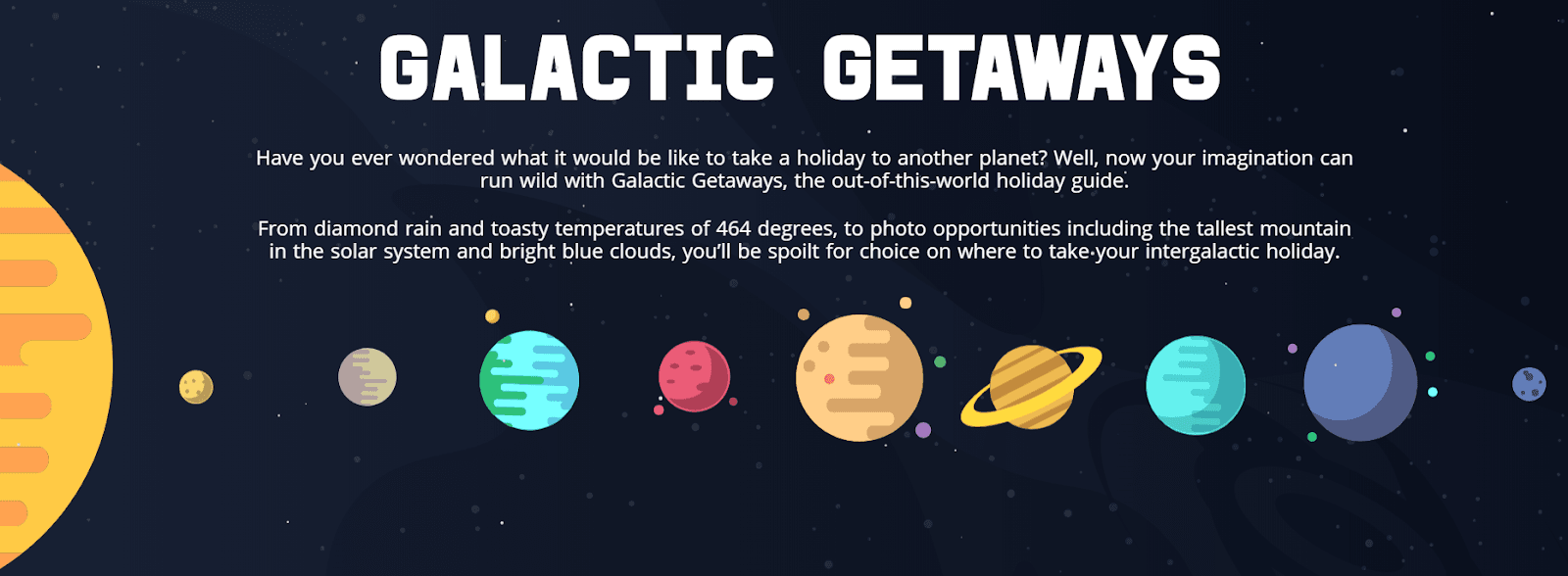On the 17th November, the hotly anticipated Leonid meteor shower will occur as Earth crosses paths with Comet 55P/Tempel-Tuttle. As debris from the comet enters Earth’s atmosphere we will be treated with a meteor shower, and those who are patient enough to wait until pre-dawn hours or after the moon has set will be able to gaze upon a kaleidoscopic sky.
With pioneers like Richard Branson making the concept of space travel seem feasible, you may have wondered yourself what it would be like to take a holiday to another planet. From concerns about the weather conditions, to excitement of what phenomenal sights there would be to see, travelling to another planet would truly provide an extraterrestrial escape from it all.
Q3 hedge fund letters, conference, scoops etc
Inspired by the Leonid meteor shower, a space travel guide named Galactic Getaways, aims to answer all of your questions surrounding space travel. And the best part of it all? Each planet offers a completely unique and customisable experience, so whether you are seeking hot temperatures, the most adrenaline-fuelled activities or jaw-dropping sights, there truly is an option for you.
Those who are seeking sunnier climes should definitely consider a trip to Mercury. It may take you 6.5 years however, with a guaranteed average temperature of 167 degrees celcius it’s perfect for sunbathing – just don’t forget the factor 50!
Alternatively, if you need to cool off somewhere chillier with extreme sports galore, then Uranus is worth a visit. With a surface consisting of swirling liquids and a 90 degree rotation, the blue planet is not for the faint hearted! Enjoy extreme jet skiing, just don’t forget to wrap up warm since the average temperature is -195 degrees.
Galactic Getaways: The holiday destinations that are truly out of this world
- A new space travel guide reimagines nine planets as holiday resorts.
- Galactic Getaways uses Nasa data to forecast the weather and travel time, as well as to suggest sports, activities and things to see.
- With diamond rain, blue clouds, liquid surfaces and the tallest mountain in the solar system, you’ll be spoilt for choice for photo opportunities.
- The piece is released in the run up to the Leonids Meteor Shower on November 17th.
Have you ever wondered what it would be like to take a holiday to another planet? Well, now your imagination can run wild with Galactic Getaways, an interactive travel guide that allows you to envision your extraterrestrial escape.
Taking the nine planets in our Solar System, the guide accounts for all of the factors that are considered when planning a holiday, from weather and average temperatures, to sports and activities included within your travel itinerary.
Pluto may be one of the smallest planets in our Solar System but the dwarf planet has some mighty features and a big heart – literally! Its heart-shaped glacier is the size of both Texas and Oklahoma combined, meaning it’s a perfect destination for a honeymoon!
As the windiest planet, Neptune offers stunning photo opportunities as well as thrill-seeking activities. Adrenaline junkies can try windsurfing, while digital dynamos can snap shots of the striking blue clouds.
Destination factors include:
- Distance from the sun (KM)
- Travel time from earth
- Average temperature (degrees C)
- Length of a day (hours)
- Moons
- Weather
- Surface type
- Interesting fact
- Sports
- Photo opportunity
Whether it’s the draw of the diamond rain on Saturn or the temptation of the toasty temperatures of 167 degrees on Mercury, this space travel guide visualises dream destinations with experiences that are truly out of this world…
To view Galactic Getaways, please visit: https://www.galactic-getaways.com/
The piece launches in the run up to the Leonids Meteor Shower on November 17th.





